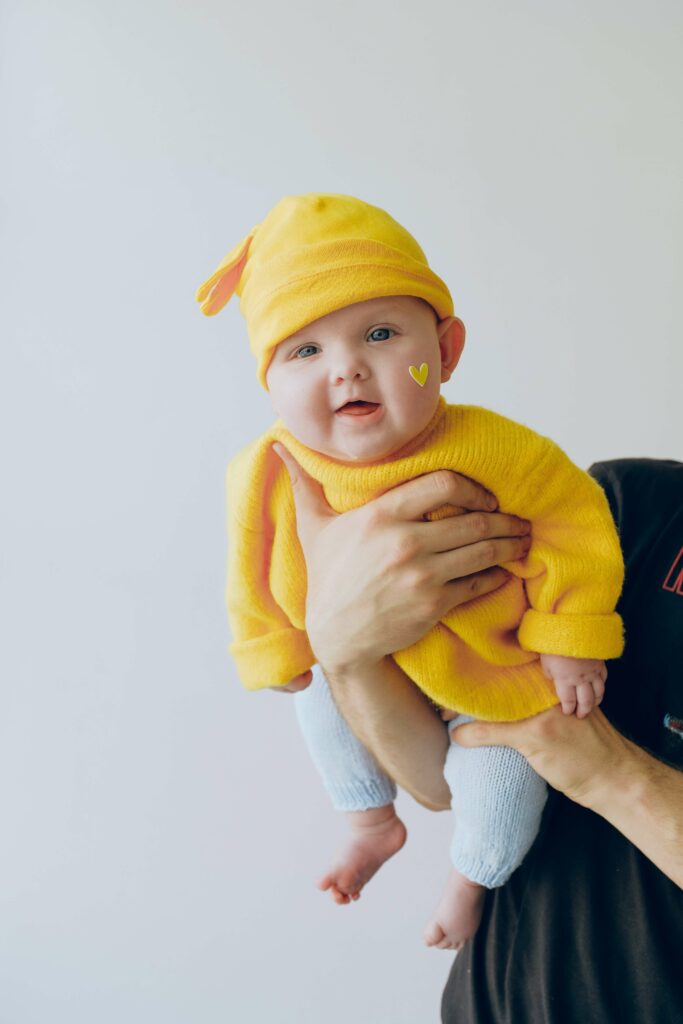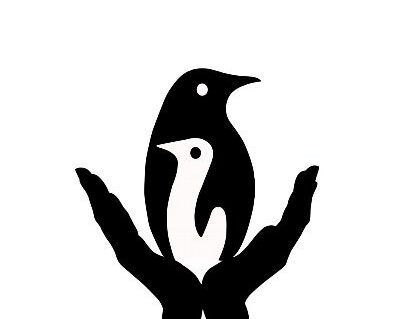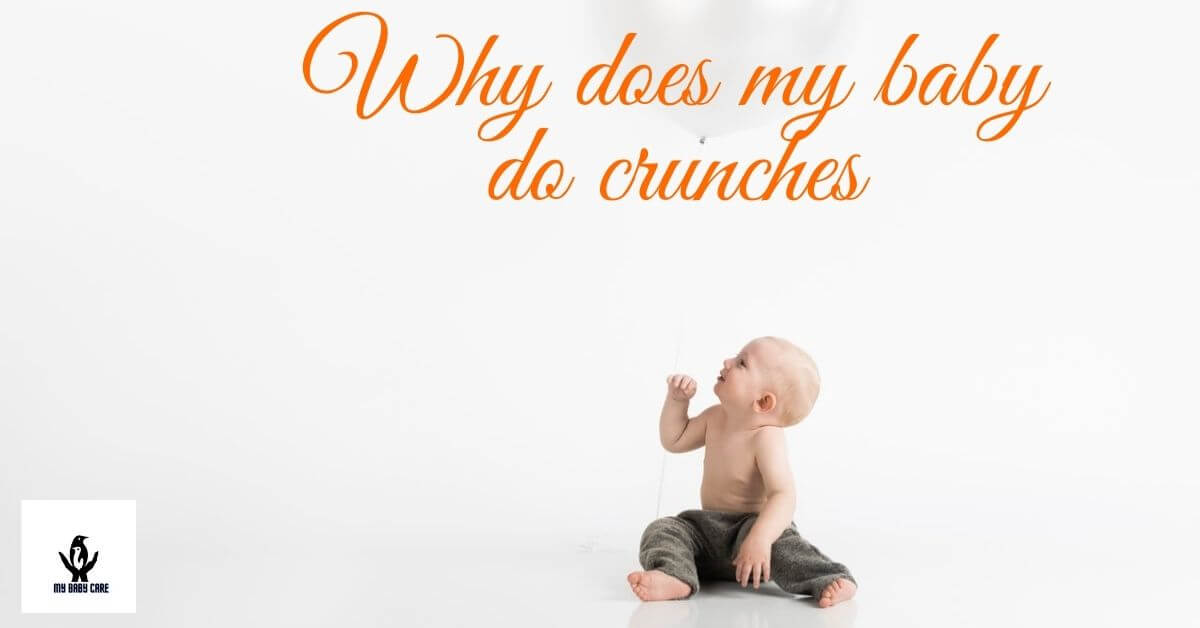Normally babies do crunches all the time. It is a normal thing. When they lie flat, they try to lift their heads a couple of inches ( 3-4 inches ) off the surface and drop their head so quickly.
They normally don’t do slow movements when doing this instead drop their head down instantly.
You can check these movement types clearly when your baby is on a semi-padded surface. So many parents question that “why does my baby do crunches? “
Doing crunches can be considered an initial step in developing body movements to sit up properly. Most babies at the age of 11 weeks try to lift their heads with outstretched legs.
They hunch their shoulders then. It can be considered as a kind of spasm generated by the little nervous system. With improving good neck control, the babies try to sit up.
These types of crunches the body are stretching movements the body normally babies do after each nap.
So these tummy crunches help to strengthen the abdominal muscles of babies later they will help with sit-up movements.
Table of Contents
1. Starting of tummy crunches – Getting ready for sit-up
Good control of neck movements is essential for sitting up. So your baby practices these neck control movements at their tummy time.
Even though the baby is not enjoying the tummy time, that time period is essential for strengthening the abdominals. When your baby lies down on the tummy, their chest is placed on the mat and the face is looking at you ( surrounding people )
Dear parents, I suggest that you need to encourage tummy time a lot. You can talk to them about keeping a few toys on a mat and keeping the baby’s chest placed on the mat.
Then the child is looking around and their neck muscles are working at every angle. It is important to keep your baby placed on their tummy when they awake. Close supervision is essential for this time
You can use a large playpen for toddlers with safety and a comfortable crawling mat. These crawling mats also give tactile sensation to your kids as well.
By using this you can offer safe and comfortable tummy time for your kid.
2. Completing baby milestone at 05 months ( Few body crunches create development in sitting up properly )
Baby development at 5 months is quite significant. By now, if your little one lies on their tummy, their exercises are quite strenuous, they extend their arms and legs and arch their back.
If the baby lies on its back, it will even be able to lift up its head and shoulders.
Your baby is not too far off sitting by this point, and may even be able to sit unsupported for a brief moment.
If your baby is already doing this kind of “sit-ups,” make sure to put plenty of cushions around, try to stay nearby, and keep a watchful eye as this can be a time of bangs, bumped heads, and tears.
You can encourage your five-month baby to develop the appropriate muscles for sitting by putting them on the stomach and placing toys just about within reach.
The baby can now stretch out an arm and bring toys into their mouths by themselves, without your needing to do it for them.
Just make sure that all toys are safe and baby-friendly, without jagged edges or small parts that can break off and be swallowed, or any peeling paint.
Your baby is passing 5 months of age. You don’t need to give solid foods at this age limit. But your health care professional strongly suggests that you can give the solid foods at this time frame.
But within this time frame, your baby loves foods that other people are eating. So the wriggling movements can be closely seen during these times
You can see another interesting activity associated with the body crunches of the baby. That is no other than blowing bubbles and raspberries. This habit is not something to worry about.
It is just a newly acquired skill that children used to show when they get amusement for a short while. It is normal for babies to show the new skills that they learned repeatedly.
Sit-up position can be improved by keeping your infant in a supported and comfy chair for your kid. Check out this wonderful product to improve your kid’s sitting ability with safe and comfort.
Babies know their names at this age limit. So you can call them by their name. Then they show their funny responses to you by showing the body crunches and a few body movements.
Also, babies use bodily crunches when expressing their emotions and even to develop their sense of humor. They get started to laugh at funny faces and they start to cry when you leave the room.
3. How long after tummy crunches the baby will sit?
Most babies show tummy crunches and other types of body crunch movements markedly at 5 months of age. At this age, those babies are just trying to sit up but that is commonly a supported sit-up attempt.
So the babies try to sit up with the support of a sofa or their parent’s lap.
In the beginning, these babies can tolerate this supported sitting for a little while, and then they are trying to arch their back by flopping backward.
While doing these supported attempts, babies gradually strengthen their back muscles a few times a day. That will enhance the balance.
Few baby categories show unaided sit-ups even before 4 months. So these categories show stomach crunches coincided with the rolling movements on the mats. This observation confirms many parents most of the time.
4. Proper handling techniques for baby sit-ups/ crunches
If you have babies at this age, you need to find semi-padded surfaces to keep your babies. You can use your crib mattress or play mat for this. Even though you provide a firm semi-padded surface for your baby.
It is essential for you to prevent head drops from your baby. If not their brains will get jostled by this motion.
Occasionally your baby may fall backward while maintaining the sitting balance on the mat. So if you are concerned about the force that the baby hits on the mat, it is advisable to check with your pediatrician.
That may not be a serious head injury but better to check if it continuously happens.
5. Infantile spasms and baby body crunches
Infantile spasms are little seizures. But dear parents, you need to prevent these infantile spasms very soon with your baby. Early intervention is the main thing for this problem and is the best option.
This epilepsy form also has a few jerky movements which are more similar to the baby crunches of the body. It typically begins 2-12 months of your baby’s age and peaks within 4-8 months of age.
You need to differentiate the basic characteristics of spasms and baby crunches.
| Infantile spasms | Baby crunches |
| May last only a second or two | Normal jerky movements |
| Each spasm occurs for 5-10 seconds in a serious | The baby can control and extend more than 10 seconds |
| Body stiffens suddenly | No stiffness of the baby |
| The back may arch and the arms legs and head may bend forward | Specially tummy crunches are seen |
| Hard to notice | Easily seen |
| Occur together with the eye boll movements | No eye movement involvement |
| Commonly occur during the baby’s sleep | Occur during the baby’s awake |

Comparison between the baby spasms and baby crunches
6. Tummy crunches improve the motor ability of your baby
Parents keep their babies on their backs most of the time. But allowing them to spend more tummy time brings them more advantages. That helps their motor ability.
PUTTING YOUR BABY ONTO THEIR STOMACH WILL STRENGTHEN THEIR MUSCLES MOSTLY.
Muscles of the neck, back, and stomach muscles are improving increasingly with this position type. AAP also approved this positional type to encourage the safe range of your baby.
Putting your baby onto their stomach is the best way to increase the tummy crunches. Start with three to five minutes sessions and extend this time duration by putting your child on a play mat.
You can encourage these tummy crunches by doing smile, talking, make funny faces with your baby while putting them on their stomach.
When both of your kids were newborns, sometimes you couldn’t help yourself from waking up multiple times a night to check in on them (on top of the other wake-up calls for night feedings).
smart socks can restore your extra peace of mind so that you can get a little more rest knowing you’ll be notified if your baby needs your attention.
Final thoughts.
Most of the time baby crunches start with tummy crunches at nearly 5 months of age. So doing tummy crunches is an early sign of getting the sit-up ability of the baby.
Some categories of babies achieve this ability before 4 months sometimes.
As soon as the baby gets the tummy crunches they can sit up with support. So their neck muscles, back muscles, and other abdominal muscles will strengthen so fast.
The balance of the baby will increasingly develop with this strengthening procedure.


Oh wow I did not know this. I feel like I should be down there with my kid doing crunches too. I am thinking that my kid has a better work out practice than I do. It is amazing that children naturally exercise to develop muscles strength.
Would I have to worry about my child over doing these baby crunches? Also would assisting then in the situp process hinder their ability to develop stronger core muscles?
Overdoing crunches is not that much considerable at the beginning. You can convert their attention to the other recreational activity while you engage with your kid in the day to day life.
Try to practice more and more engagement with your kid by talking and showing gestures to the child.
Check out the basic sensory needs of your kid. Check out my resource articles at the following link https://mybabycaresolutions.co…
thanks for sharing your valuable ideas.
I love reading other peoples opinions on babies development, it’s always reassuring to read. I have 4 children and I think it’s important that people know that every baby is different and progress at their own speed. my oldest son didn’t start walking until he was 1 and a half, my second oldest started walking at 8 months. Everyone is different. Absolutely love the recommendations for baby items.
Don’t worry regarding the delayed developmental milestones.We all have different phase of development. Most important thing is it conider both physical and phsyco-social development tofether for your kid.
https://mybabycaresolutions.co… read about this article for infant and toddler development and get more detailed insight.thanls for sharing your valuable ideas